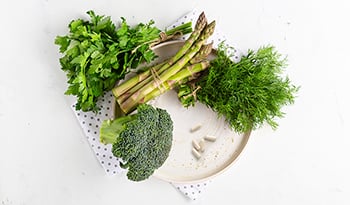The Ultimate Guide to Amino Acids
DISCLAIMER:This blog does not intend to provide diagnosis...
- In this article:
- Valine, Isoleucine, Leucine(BCAAs)
- Histidine
- L-Lysine
- Methionine
- Phenylalanine and Tyrosine
- Threonine
- Tryptophan
- Glutamine

Amino acids are the building blocks of protein and are vital for a variety of bodily functions. Without protein, the human body would not be able to function as it does. Every biochemical process that occurs to sustain life is powered by protein.
Not only is the human body able to use amino acids for various purposes but is also able to recycle them. The body is very efficient in breaking down old protein into amino acids so they can be reused to manufacture new protein.
Of the 20 amino acids found in your body’s protein, nine (9) are considered “essential” amino acids. They are considered essential because the human body is unable to produce them internally and they must be consumed in one’s diet. As a result, eating a well-balanced diet is crucial for overall health.
The first three amino acids that we need to retrieve from our diet include the three BCAAs (Branched Chain Amino Acids ) known as Valine, Isoleucine, Leucine. The other six amino acids are Histidine, Lysine, Methionine, Phenylalanine, Threonine, Tryptophan. We will discuss these in more detail and the role they each play in our health and wellbeing.
Valine, Isoleucine, Leucine(BCAAs)
Valine, Isoleucine, and Leucine are known as the branched-chain amino acids (BCAAs) which refers to the “branched” nature of their molecular structure. Researchers have found that supplementation with BCAAs can help with muscle protein synthesis, lean muscle growth, supporting muscle recovery and reducing muscle fatigue, especially after a workout.
Additional Benefits include:
- Improve symptoms of insomnia and anxiety
- Appetite suppressant
- Regulation of the immune system
- Aid in muscle tissue recovery
- Increase exercise endurance
Natural sources of BCAAs include red meat, dairy products, legumes, nuts, grains, and seeds.
Suggested dose of BCAAs is approximately 2-4 grams per hour during exercise and immediately after during the recovery period.
Histidine
Histidine is a precursor for several molecules and serves several functions in the body. One of the functions that histidine serves is that it occupies an essential position in a protein known as hemoglobin and myoglobin. Hemoglobin and myoglobin are both proteins that are in charge of binding oxygen and carrying it throughout the body to where it is required.
The myoglobin protein is in charge of carrying and transporting oxygen to the muscles while hemoglobin is in charge of carrying oxygen in the blood to the rest of the body. The histidine present in hemoglobin and myoglobin helps with their stabilization as well as their ability to bind to oxygen.
The body can also convert histidine to histamine, a molecule that is present in all tissues. Histamine is the molecule that is the primary culprit in eliciting allergic reactions such as breaking out in hives and sneezing in response to certain allergens. Histamine also plays a role in the intestinal tract and helps stimulate acid secretion in the stomach. Your doctor may prescribe an “Antihistamine” to help relieve symptoms of allergies and acid reflux.
Some foods rich in histidine include eggs, beef, lamb, beans, whole grains, cheese, pork, chicken, soy, turkey, seeds, and nuts. Histidine can also be found in most whey and vegan protein powders.
L-Lysine
L-Lysine, like the other amino acids, has several functions in the body but two of the most notable ones are the functions it serves in our DNA and in the creation of collagen. Lysine helps prevent DNA from being damaged or negatively affected.
L-Lysine is also important in the creation of collagen and only works when adequate vitamin C is present. Collagen is the building block of our bones, blood vessels, tissue, eyes, kidneys, and more. In addition, collagen is required to keep one’s teeth tightly in place. There are several steps in the process of creating collagen, with each step focused on making it either stronger or more flexible. Without collagen, we would be unable to structurally support our body. It is important for healthy, strong, and durable tissue and organ development.
Many also rely on L-lysine supplementation to help prevent viral infection outbreaks, such as those caused by HSV or Herpes Simplex Virus. A dose of 3,000 mg per day is required to keep the infection suppressed, according to studies.
Some foods that are rich in L-Lysine include fish, ground beef, chicken, soybean, azuki beans, kidney beans, navy beans, milk, split peas, and lentils.
Methionine
Methionine has an integral role in the creation of various hormones and molecules found in the body, in particular, it plays a role in the synthesis of a molecule called S-Adenosyl Methionine, or SAMe. SAMe is formed from the combination of Methionine and ATP (Adenosine Triphosphate) the main “energy molecule” of the body. SAMe has a role in various parts of the body and is believed to also benefit the brain. Scientific studies on rats have shown that administration of SAMe can result in some mild antidepressant effects.
Additionally, SAMe is needed for the creation of hormones such as Norepinephrine and Epinephrine. Both of these have various effects on the body, with Epinephrine being more well known as the “fight or flight” hormone, sometimes referred to as Adrenaline.
These hormones get released in stressful situations and allow us to respond by either by running away or by facing it head-on.
Methionine can be obtained from foods such as eggs, meat, fish, seeds, some nuts, and certain cereal grains.
Phenylalanine and Tyrosine
Phenylalanine is an essential amino acid found in many foods. Benefits of Phenylalanine may include the treatment of chronic pain. Also, animal studies have even suggested an improvement in walking, rigidity, speech, and depression that is frequently associated with Parkinson's disease.
The amino acid Phenylalaninecan also be transformed into amino acid Tyrosine. With the help of SAMe, tyrosine can get converted to epinephrine (adrenaline) and then get converted to Norepinephrine (noradrenaline) which is a chemical found in the brain responsible for the promotion of alertness, memory, mood elevation, and appetite suppression.
Tyrosine is also a precursor for a neurotransmitter known as dopamine, a hormone released by our nerve cells.
Dopamine is thought to play a primary role in the reward and desire pathway in our brains. Dopamine may also play a role in addiction to drugs like cocaine, methamphetamines, or even nicotine. Moreover, diseases like Parkinson's that involve a series of movement issues and tremors, is associated with a decreased amount of dopamine in a specific part of the brain.
Tyrosine can naturally be found in foods such as chicken, turkey meat, milk, yogurt, cottage cheese, fish, peanuts, almonds, sesame seeds, soy products, and avocados.
Threonine
Threonine directly helps support the central nervous system, immune system, and promotes a healthy heart and liver. One role is to help synthesize other amino acids such as glycine and serine which help produce collagen, elastin, and other muscle tissues. Threonine aids in building stronger teeth and bones and by regulating the immune system. It's also essential in the wound healing process.
Scientists have found threonine to be useful in treating Lou Gehrig’s disease, also known as Amyotrophic Lateral Sclerosis (ALS).
Adequate levels can be found in most meats, dairy, and eggs. Vegans can get their healthy portion of threonine from wheat germ, nuts, beans, and seeds.
Tryptophan
Tryptophan is responsible for the construction of numerous important molecules such as protein, serotonin, melatonin, and other neurotransmitters vital for the human body.
Roles of Serotonin:
- Regulating mood and helps fight anxiety and depression
- Pain perception
- Sleep
- Temperature regulation
- Blood pressure regulation
Prescription antidepressants such as Selective Serotonin Reuptake Inhibitors, SSRIs (fluoxetine, paroxetine, sertraline) help increase brain serotonin level.
Tryptophan is also required to make Melatonin, which plays a large part in the circadian rhythm and sleep. Melatonin is secreted into the body in different cycles of the day and helps promote the sleep-wake cycle that we are all used to.
Melatonin production diminishes as one ages, which likely explains that reason we are more easily awakened as we age and also why falling asleep becomes more difficult. Melatonin supplements are frequently taken to help one fall asleep and is also used by many with Jet lag disorder, shift work disorder, and non-24 sleep-wake disorder.
Therefore, Serotonin and Melatonin, both derivatives of Tryptophan, play vital roles in living a healthy quality-filled life.
Tryptophan can be found in salmon, chicken, turkey, eggs, spinach, seeds, nuts, soy products and dairy.
Another notable non-essential amino acid that is important for human function is Glutamine.
Glutamine
Scientists have found that Glutamine is one of the most abundant free amino acids present in the human body. It is responsible for many metabolic processes. Glutamine is considered a “glucogenic” amino acid implying that if and should your body requires additional energy source in the form of glucose, the body can convert glutamine into glucose and provide the body with the energy it needs.
Some of the most rapidly dividing cells in your body, including the white blood cells that help fight infection (also known as leukocytes), utilize glutamine to provide energy for cell replication.
According to studies, Glutamine supplementation resulted in quicker recovery periods and significantly less soreness following vigorous exercise. Therefore, glutamine has a direct effect on muscle regrowth and function as well as proper immune system function.
Although your body naturally produces glutamine, in times of extreme stress such as exercise or illness, the body may enter into a deficit. Researchers believe that the human body releases the main stress hormone, Cortisol, which lowers the storage of glutamine. Therefore, in times of high stress, it is important to be cognizant of glutamine deficiency.
Signs of Glutamine Deficiency:
- Anxiety
- Weakened immune system
- Delayed recovery post exercise
- Constipation or diarrhea
Glutamine is also important for those with Leaky Gut and/or Irritable Bowel symptoms. It is believed to help keep the gut lining healthy.
Natural sources of Glutamine include chicken, fish, cabbage, spinach, dairy, tofu, lentils, beans. Normal dietary intake of Glutamine is approximately 3 to 6 g per day.
Amino Acids, Protein and Quality of Life
In conclusion, amino acids are the building blocks to every protein found in the human body and are essential to health, living and improved quality of life. A well-balanced diet is the most important thing a person can do to ensure adequate amino acids are being consumed.
It is important to recognize that nine of the most important amino acids are not synthesized naturally from our bodies and must be obtained by diet and supplementation. Those who workout regularly frequently focus on BCAAs, which are frequently found to be beneficial according to scientific studies. If you are experiencing symptoms that potentially resemble deficiency it is important to consult with your physician.
References:
- Young SN, Shalchi M. The effect of methionine and S-adenosylmethionine on S-adenosylmethionine levels in the rat brain. J Psychiatry Neurosci. 2005;30(1):44–48.
- Miller D, Reddy BY, Tsao H. Molecular Targeted Therapies. In: Kang S, Amagai M, Bruckner AL, Enk AH, Margolis DJ, McMichael AJ, Orringer JS. eds. Fitzpatrick's Dermatology, 9e New York, NY: McGraw-Hill; . http://accessmedicine.mhmedical.com/content.aspx?bookid=2570§ionid=210444152. Accessed April 07, 2019.
- Rodwell VW. Biosynthesis of the Nutritionally Nonessential Amino Acids. In: Rodwell VW, Bender DA, Botham KM, Kennelly PJ, Weil P. eds. Harper's Illustrated Biochemistry, 31e New York, NY: McGraw-Hill; . http://accessmedicine.mhmedical.com/content.aspx?bookid=2386§ionid=187832918. Accessed April 07, 2019.
- Moriwaki, M., Wakabayashi, H., Sakata, K. et al. J Nutr Health Aging (2019) 23: 348. https://doi.org/10.1007/s12603-019-1172-3
- err J. CONNECTIVE TISSUE AND BONE. In: Janson LW, Tischler ME. eds. The Big Picture: Medical Biochemistry New York, NY: McGraw-Hill; . http://accessmedicine.mhmedical.com/content.aspx?bookid=2355§ionid=185845003. Accessed April 07, 2019.
- General Principles & Energy Production in Medical Physiology. In: Barrett KE, Barman SM, Brooks HL, Yuan JJ. eds. Ganong's Review of Medical Physiology, 26eNew York, NY: McGraw-Hill; . http://accessmedicine.mhmedical.com/content.aspx?bookid=2525§ionid=204290215. Accessed April 07, 2019.
- Kennelly PJ, Rodwell VW. protein: Myoglobin & Hemoglobin. In: Rodwell VW, Bender DA, Botham KM, Kennelly PJ, Weil P. eds. Harper's Illustrated Biochemistry, 31e New York, NY: McGraw-Hill; . http://accessmedicine.mhmedical.com/content.aspx?bookid=2386§ionid=187830863. Accessed April 07, 2019.
- Integrative Medicine (Encinitas). 2017 Jun;16(3):42-46.L-Lysine and HSV Infection
- Rodwell VW. Conversion of Amino Acids to Specialized Products. In: Rodwell VW, Bender DA, Botham KM, Kennelly PJ, Weil P. eds. Harper's Illustrated Biochemistry, 31e New York, NY: McGraw-Hill; . http://accessmedicine.mhmedical.com/content.aspx?bookid=2386§ionid=187833183. Accessed April 07, 2019.
- Rodwell VW. Catabolism of the Carbon Skeletons of Amino Acids. In: Rodwell VW, Bender DA, Botham KM, Kennelly PJ, Weil P. eds. Harper's Illustrated Biochemistry, 31e New York, NY: McGraw-Hill; . http://accessmedicine.mhmedical.com/content.aspx?bookid=2386§ionid=187833082. Accessed April 07, 2019.
- AMINO ACIDS AND protein. In: Janson LW, Tischler ME. eds. The Big Picture: Medical Biochemistry New York, NY: McGraw-Hill; . http://accessmedicine.mhmedical.com/content.aspx?bookid=2355§ionid=185844299. Accessed April 07, 2019.
- Rodwell VW. Biosynthesis of the Nutritionally Nonessential Amino Acids. In: Rodwell VW, Bender DA, Botham KM, Kennelly PJ, Weil P. eds. Harper's Illustrated Biochemistry, 31e New York, NY: McGraw-Hill; . http://accessmedicine.mhmedical.com/content.aspx?bookid=2386§ionid=187832918. Accessed April 07, 2019.
- DeRouchey J, Hoover B, Rau DC. A comparison of DNA compaction by arginine and lysine peptides: a physical basis for arginine rich protamines. Biochemistry. 2013;52(17):3000–3009. doi:10.1021/bi4001408
- Hullár I e. Effects of oral L-carnitine, L-lysine administration and exercise on body composition and histological and biochemical parameters in pigeons. - PubMed - NCBI. Ncbi.nlm.nih.gov. https://www.ncbi.nlm.nih.gov/pubmed/18477325. Published 2019. Accessed April 14, 2019.
- Legault Z e. The Influence of Oral L-Glutamine Supplementation on Muscle Strength Recovery and Soreness Following Unilateral Knee Extension Eccentric Exercise. - PubMed - NCBI. Ncbi.nlm.nih.gov. https://www.ncbi.nlm.nih.gov/pubmed/25811544. Published 2019. Accessed April 14, 2019.
- Catabolism of the Carbon Skeletons of Amino Acids | Harper's Illustrated Biochemistry, 31e | AccessMedicine | McGraw-Hill Medical. Accessmedicine.mhmedical.com. https://accessmedicine.mhmedical.com/content.aspx?sectionid=187833082&bookid=2386&jumpsectionid=187833088&Resultclick=2#1162228792. Published 2019. Accessed April 14, 2019.
- General Principles & Energy Production in Medical Physiology | Ganong's Review of Medical Physiology, 26e | AccessMedicine | McGraw-Hill Medical. Accessmedicine.mhmedical.com. https://accessmedicine.mhmedical.com/content.aspx?sectionid=204290215&bookid=2525&jumpsectionid=204290376&Resultclick=2. Published 2019. Accessed April 14, 2019.
- Moriwaki M e. The Effect of Branched Chain Amino Acids-Enriched Nutritional Supplements on Activities of Daily Living and Muscle Mass in Inpatients with Gait Imp... - PubMed - NCBI. Ncbi.nlm.nih.gov. https://www.ncbi.nlm.nih.gov/pubmed/30932133. Published 2019. Accessed April 14, 2019.

 By Dr. Eric Madrid, M.D.
By Dr. Eric Madrid, M.D.


